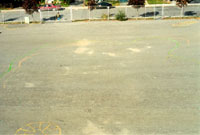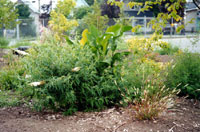Biodiversity
Often referred to as "biodiversity", biological diversity means the diversity of all life on Earth including genetic diversity, species, ecosystems and the natural systems and processes that are essential to life on Earth such as oxygen and soil production and water purification.
Transformation or greening
Click to enlarge
 |
 |
Click to enlarge
 |
There are several terms used to describe improving the environmental, educational, social, play and health-related quality of school grounds. "Naturalization" and "restoration" are commonly used; however, these terms specifically relate to the natural environment. "Transformation" or "greening" are intended to be more holistic in scope and are flexible enough to encompass practically any school grounds improvement project. They are less explicit than "naturalization" or "restoration". In addition to naturalizing the grounds, it includes creating outdoor classroom for cross-curricula activities and spaces to encourage imaginative play and provide social opportunities. It also includes promoting physical and spiritual health and the development in young people of a sense of well-being, a sense of ownership, a sense of place and a sense of belonging to a place.
Naturalization
The term "naturalization" is widely used to describe recreating natural spaces. Naturalization is a modified version of restoration that can be applied to a number of non-traditional design projects. According to their level of ecological correctness, some naturalization projects could be considered restoration. Naturalization usually involves using native plants in ways that imitate nature; it can also incorporate exotic plants and traditional design principles. It is this distinction that separates naturalization from restoration.
Restoration
Habitat restoration is the process of reestablishing to the fullest extent possible the structure, function and integrity of indigenous ecosystems and the self-sustaining habitats they provide. In most urban environments, the conditions required for supporting indigenous ecosystems have been dramatically altered and will no longer sustain the natural areas that existed prior to urbanization.
Beautification
Beautification is an inadequate term to describe school grounds transformation concepts. Planting trees and flowers will make the grounds aesthetically more pleasing but it will not necessarily enhance the ecological, educational, social, play and health-related aspects of children's outdoor school environments. Transforming or greening school grounds should encompass so much more than simply making them look better.
The hidden curriculum
In the context of the school grounds, the hidden curriculum refers to what children learn through their senses from the environments in which they spend a lot of their school lives. The formal curriculum is deliberately taught to students. The informal curriculum is learned through participating in organized games and sports, and playing and socializing in specially-created spaces. The hidden curriculum is what is passively learned through messages received by the senses directly from the environment and the living and non-living things in it.
We continuously receive an enormous amount of information through our senses from our surroundings. We have physical, emotional, rational and irrational, and conscious and subconscious reactions to, for example, colours, light, dark, sounds, noises, smells, speed, shapes, forms, heights, certain animals, and wide-open, enclosed, underground, crowded and empty spaces. The hidden curriculum relative to transforming school grounds is very important because it has a powerful effect on children's behaviour and attitude. It affects their sense of safety, well-being, of being cared for, respected and valued as well as their comfort, self esteem and interest in learning.
Native species
Although the planting of local native species makes sense from an ecological perspective, it should be remembered that most school grounds in no way resemble native species' natural habitat.
Planting native species is recommended wherever site conditions permit, however, non-native, non-invasive species are very useful for planting in harsh, urban conditions where native species are unlikely to survive. It is preferable to plant a hardy, non-invasive, non-native tree than no tree at all or a native tree that will not survive.
Planting non-native, non-invasive trees and other plants in difficult spots can help to improve conditions for native species planted in other locations on the site. Non-native species that tolerate hard-surface, urban conditions can be planted along the edges of schoolyards next to roadways. They can serve as a windbreak and help to block salt spray from traffic in Winter and cool and moisturize the air in Summer. This will help improve growing conditions for native species planted further back from the road.
Planting native species only, is often advocated, but it is the nature of plants to move from one place to another by way of wind, water and animals. Plants did not move quite so fast before humans began to travel and trade extensively on a global scale, deliberately or accidentally carrying plants or plant seeds with them from one place to another.
A high percentage of wildflowers in Canada have only become established here over the past two centuries. Many of these plants are now 'naturalized' and are useful to wildlife, and most of them are probably here to stay for a while. For this reason, in addition to native species, the plant lists on this website include non-invasive naturalized and introduced species that enhance wildlife habitat in urbanized areas.